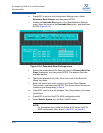
8–Configuring FCoE in a Linux Environment
Boot-from-SAN
FE0254601-00 A 8-37
5. Configure the UEFI server. To configure a BIOS server, refer to Step 4. The
boot-from-SAN configuration process for UEFI servers depends on the
server make and model. The following instructions configure the adapter for
boot-from-SAN using the EFI shell. If a UEFI shell is not available on the
server being configured, consult the server documentation for information
about obtaining a shell or for alternate ways to configure the adapter.
a. When the server is booting up, select EFI shell from the EFI Boot
manager menu.
b. In the EFI shell, issue the following command to display a list of
installed EFI drivers.
drivers
c. Under the heading DRIVER NAME, find the driver with name QLogic
Fibre Channel Driver. Locate the DRV column, and make note of the
driver handle number.
d. To display the list of adapters that are managed by this driver, issue the
following command. Locate and note the controller handle number
inside the brackets labeled Ctrl [ ].
drvcfg <driverhandle>
e. Configure the switch with a zone that includes the adapter port and
one storage array port using either soft zoning (WWPN-based) or hard
zoning (port number-based), and enable the zone. Soft zoning is
recommended because, if a server malfunctions, you can move the
adapter to another host without reconfiguration.
f. Create an appropriately-sized LUN on the storage array. The LUN size
depends on the operating system to be installed. Add this LUN to a
host group containing the QLogic adapter.
g. Set the host type/mode for the host group that corresponds to the
operating system to be installed. The new LUN should be LUN 0. For
information about using LUNs other than LUN 0, refer to “Booting from
SAN Using a LUN Other Than LUN 0” on page 8-40.
h. At the EFI shell, issue the following command to start the EFI driver
configuration protocol.
drvcfg –s <driverhandle> <controllerhandle>


















